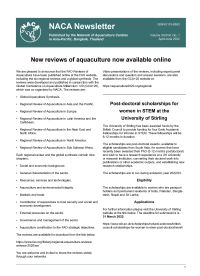In this issue:
New reviews of aquaculture now available online; Post-doctoral scholarships for women in STEM at the University of Stirling; Research breakthrough seen to curb shortage of "poor man's fish"; Free online aquaculture courses; Fishing for life 2022: South and South-East Asian Conference on Small Scale Fisheries and Aquaculture; Reported Aquatic Animal Diseases in the Asia-Pacific Region during the Third Quarter of 2021; Shrimp 2022: INFOFISH World Shrimp Trade Conference and Exhibition; Tuskfish CMS v2.0.3 available.
A scientific breakthrough at a research center in the Philippines might finally be the long-term solution to the perennial shortage of round scad (Decapterus spp.), known as the “poor man’s fish” in the country. In a world’s first, researchers successfully spawned the round scad Decapterus macrosoma in captivity at the Southeast Asian Fisheries Development Center, Aquaculture Department (SEAFDEC/AQD) in Tigbauan, Iloilo, marking a critical milestone towards farming the fish, locally known as galunggong. Round scad is considered a staple fish in the Philippines with over 202,000 metric tons harvested by commercial and municipal fisheries in 2020 according to government statistics.
The University of Stirling has been awarded funds by the British Council to provide funding for four Early Academic Fellowships for Women in STEM. These fellowships will be 6-12 months in duration. The scholarships are available to women who are passport holders and permanent residents of India, Pakistan, Bangladesh, Nepal and Sri Lanka. For further information please visit the University of Stirling website. The deadline for submissions is 31 March 2022.
We are pleased to announce that the FAO Reviews of Aquaculture have been published online at the FAO website, including the six Regional Reviews and a Global Synthesis, which were developed and published in conjunction with the Global Conference on Aquaculture Millennium +20 (GCA+20). The publications are linked below. Video presentations of the reviews, including expert panel discussions and question and answer sessions, are also available from the GCA+20 website.
Shanghai Ocean University is offering PhD scholarships for the majors of Aquaculture, Hydrobiology, Fishery Economics and Management, Fishery Resources Management and Fishery Environment Protection and Management. The scholarship program is open to international candidates under 35 years old who have a master’s degree with a good academic record and outstanding research potential. The scholarships include a full tuition fee waiver, accommodation, living allowance and medical insurance. Applicants are highly recommended to submit the application before March 30, 2022. The final application deadline is April 15, 2022.




